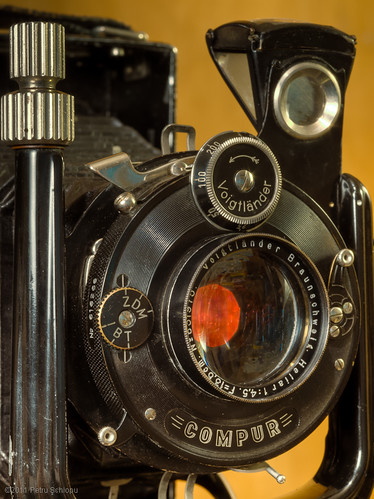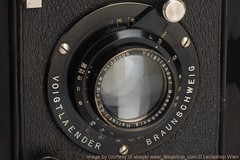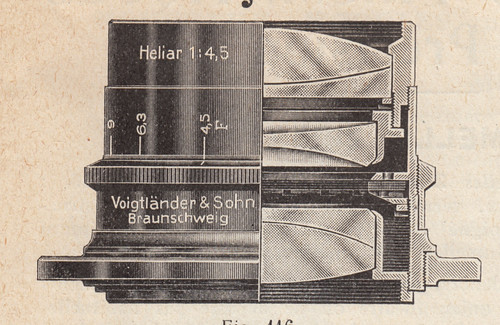Difference between revisions of "Heliar"
(added image) |
m |
||
| Line 4: | Line 4: | ||
|image= http://farm7.staticflickr.com/6149/5941999973_95c7d1f881.jpg | |image= http://farm7.staticflickr.com/6149/5941999973_95c7d1f881.jpg | ||
|image_align= right | |image_align= right | ||
| − | |image_text= Heliar on [[Bergheil|Voigtländer Bergheil]] | + | |image_text= [[Voigtländer]] Braunschweig Heliar 1:4.5 f=13.5cm on [[Bergheil|Voigtländer Bergheil]] |
|image_by= Petru Schiopu | |image_by= Petru Schiopu | ||
|image_rights= wp | |image_rights= wp | ||
| Line 10: | Line 10: | ||
The '''Heliar''' is a lens designed and made by [[Voigtländer]]. It was patented just after the turn of the 20th century in Germany (1901), Britain (1901) and the USA (1902).<ref name=Greenleaf>Greenleaf, Allen R. (1950), ''Photographic Optics''. Macmillan, New York. pp80 & 83.</ref> It comprises five glass elements: the front group is a cemented doublet of positive power, composed of a crown glass element at the front, cemented to a flint glass; there is a central, diverging element of a different crown glass, and the rear group is another cemented doublet, identical to the front group.<ref name=USPat>[http://www.google.co.uk/patents?hl=en&lr=&vid=USPAT716035 US Patent 716035] of 1902, in the name of Carl Harting, for Voigtländer, at Google.</ref> Thus it seems like a development of a [[Tessar]] design, with the front group divided to allow more corrections; however, the Heliar clearly predates the Tessar by about a year. | The '''Heliar''' is a lens designed and made by [[Voigtländer]]. It was patented just after the turn of the 20th century in Germany (1901), Britain (1901) and the USA (1902).<ref name=Greenleaf>Greenleaf, Allen R. (1950), ''Photographic Optics''. Macmillan, New York. pp80 & 83.</ref> It comprises five glass elements: the front group is a cemented doublet of positive power, composed of a crown glass element at the front, cemented to a flint glass; there is a central, diverging element of a different crown glass, and the rear group is another cemented doublet, identical to the front group.<ref name=USPat>[http://www.google.co.uk/patents?hl=en&lr=&vid=USPAT716035 US Patent 716035] of 1902, in the name of Carl Harting, for Voigtländer, at Google.</ref> Thus it seems like a development of a [[Tessar]] design, with the front group divided to allow more corrections; however, the Heliar clearly predates the Tessar by about a year. | ||
| − | + | {{Flickr_image | |
| + | |image_source= http://www.flickr.com/photos/phollectormo/8578810357/in/pool-camerawiki | ||
| + | |image= http://farm9.staticflickr.com/8392/8578810357_d2b53d67c2_n.jpg | ||
| + | |image_align= left | ||
| + | |image_text= [[Voigtländer]] Braunschweig Heliar 1:4.5/24cm | ||
| + | |image_by= phollectormo | ||
| + | |image_rights= wp | ||
| + | }}{{brl}} | ||
Voigtländer used the lens in the way [[Zeiss Ikon|Zeiss]] used the [[Tessar]]; it was the lens fitted to most of the company's high-specification cameras for many years. | Voigtländer used the lens in the way [[Zeiss Ikon|Zeiss]] used the [[Tessar]]; it was the lens fitted to most of the company's high-specification cameras for many years. | ||
The original Heliar design was an f/4.5 lens; f/3.5 versions of the same optical design were offered fairly soon after (''alongside'' the f/4.5). The wider-aperture lens has a slightly narrower field of view.<ref name=Cat1927>A [http://www.cameraeccentric.com/html/info/voigtlander_1.html Voigtländer catalogue] of 1927, at [http://www.cameraeccentric.com/ Camera Eccentric] shows both the f/4.5 and f/3.5 lenses. The angle of view of the f/3.5 lens is given as about 50°; that of the f/4.5 is given as about 58° (up to focal length of 24 cm; for some reason (perhaps simply bellows extension) it is given as 45° beyond that.</ref>). | The original Heliar design was an f/4.5 lens; f/3.5 versions of the same optical design were offered fairly soon after (''alongside'' the f/4.5). The wider-aperture lens has a slightly narrower field of view.<ref name=Cat1927>A [http://www.cameraeccentric.com/html/info/voigtlander_1.html Voigtländer catalogue] of 1927, at [http://www.cameraeccentric.com/ Camera Eccentric] shows both the f/4.5 and f/3.5 lenses. The angle of view of the f/3.5 lens is given as about 50°; that of the f/4.5 is given as about 58° (up to focal length of 24 cm; for some reason (perhaps simply bellows extension) it is given as 45° beyond that.</ref>). | ||
| − | + | {{Flickr_image | |
| + | |image_source= http://www.flickr.com/photos/uwe_kulick/10911259795/ | ||
| + | |image= http://farm6.staticflickr.com/5481/10911259795_3f40b4029b_m.jpg | ||
| + | |image_align= left | ||
| + | |image_text= [[Voigtländer]] Braunschweig Heliar 1:4.5 F=12cm | ||
| + | |image_by= ebayer www_leicashop_com | ||
| + | |image_rights= | ||
| + | }} | ||
{{br}} | {{br}} | ||
{{Flickr_image | {{Flickr_image | ||
| Line 20: | Line 34: | ||
|image= http://farm6.static.flickr.com/8473/8093071945_38d2d5285e.jpg | |image= http://farm6.static.flickr.com/8473/8093071945_38d2d5285e.jpg | ||
|image_align= right | |image_align= right | ||
| − | |image_text= [[Voigtländer]] Heliar | + | |image_text= [[Voigtländer]]&Sohn Heliar 1:4.5 |
|image_by= Dirk HR Spennemann | |image_by= Dirk HR Spennemann | ||
}} | }} | ||
Revision as of 00:21, 18 November 2013

|
| Voigtländer Braunschweig Heliar 1:4.5 f=13.5cm on Voigtländer Bergheil image by Petru Schiopu (Image rights) |
The Heliar is a lens designed and made by Voigtländer. It was patented just after the turn of the 20th century in Germany (1901), Britain (1901) and the USA (1902).[1] It comprises five glass elements: the front group is a cemented doublet of positive power, composed of a crown glass element at the front, cemented to a flint glass; there is a central, diverging element of a different crown glass, and the rear group is another cemented doublet, identical to the front group.[2] Thus it seems like a development of a Tessar design, with the front group divided to allow more corrections; however, the Heliar clearly predates the Tessar by about a year.

|
| Voigtländer Braunschweig Heliar 1:4.5/24cm image by phollectormo (Image rights) |
Voigtländer used the lens in the way Zeiss used the Tessar; it was the lens fitted to most of the company's high-specification cameras for many years.
The original Heliar design was an f/4.5 lens; f/3.5 versions of the same optical design were offered fairly soon after (alongside the f/4.5). The wider-aperture lens has a slightly narrower field of view.[3]).

|
| Voigtländer Braunschweig Heliar 1:4.5 F=12cm image by ebayer www_leicashop_com |

|
| Voigtländer&Sohn Heliar 1:4.5 image by Dirk HR Spennemann |
Notes
- ↑ Greenleaf, Allen R. (1950), Photographic Optics. Macmillan, New York. pp80 & 83.
- ↑ US Patent 716035 of 1902, in the name of Carl Harting, for Voigtländer, at Google.
- ↑ A Voigtländer catalogue of 1927, at Camera Eccentric shows both the f/4.5 and f/3.5 lenses. The angle of view of the f/3.5 lens is given as about 50°; that of the f/4.5 is given as about 58° (up to focal length of 24 cm; for some reason (perhaps simply bellows extension) it is given as 45° beyond that.